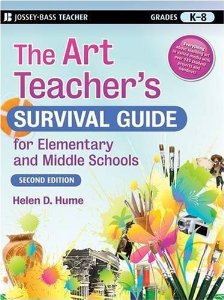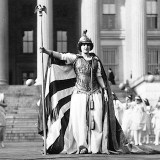Beyond the Basics of Art Teacher Survival
The Art Teacher’s Survival Guide for Elementary and Middle Schools
By Helen D. Hume
(Wiley/Jossey-Bass, 2008 – Learn more)

The Art Teacher’s Survival Guide for Elementary and Middle Schools is a great review of the elements of art and the principles of design. Along with these features, this book is loaded with new lesson plans and projects on everything from drawing to working with clay to digital arts.
For veteran teachers, there are also numerous ideas dealing with 21st century learning skills (digital art forms); for the new teacher, there are explicit lessons on any type of project to be completed.

Although the ideas are user friendly, be cautious that for some projects students will need to bring items from home – which can always be a struggle. If a teacher has access to digital and/or video cameras, pages 417-485 outline 3 units for students. These units include simple projects like taking photographs and editing them as well as making a TV commercial.
Curriculum mapping & inclusion
I think one of the book’s strengths is its curriculum mapping pages. For each grade level, there is a section showing what the students should be able to do by the end of the year. For new teachers, this section also gives characteristics of the grade level. VERY HELPFUL! For those who have inclusive classrooms, this book gives suggestions for adaptive projects.
Furthermore, this book gives ways to link art to other content areas. Each lesson has additional activities which would enhance science, social studies, language arts, reading, etc. Each chapter is broken into “for the teacher” and “for the student” sections. The teacher section gives necessary historical background, needed materials, and alternative projects. The directions in the student section are specific and easy to follow. There are illustrations and examples of projects in almost every chapter.
Every art teacher struggles to teach art history and appreciation while engaging students. This book has an entire chapter on this topic, and it is not your normal “boring” art history. The chapter includes illustrated time lines showing what was happening in the world in science, mathematics, social studies, language arts, music, and art developments. In addition to the time line, which catches student’s attention, there are “art projects for integrated learning.” This gives the students hands-on activities to make connections to the era covered on the time line.
My overall thoughts – although pretty obvious – are that every art teacher could benefit by having this book in their personal libraries. It may not be one you use every day, but it is one to reference on a regular basis. I have used many lessons already and plan to continue the year using it. And next year – it will be a primary source for my art classes!
Carrie Manders is a middle school art teacher in a small rural community. She has been teaching art for 10 plus years as part of an exploratory wheel to students 6-8. Carrie also teaches language arts to 6th graders and uses ELA content to expand the art program.
ALSO SEE: Julia Colombo’s MiddleWeb review of Helen Hume’s The Art Teacher’s Book of Lists (2nd Edition).

































